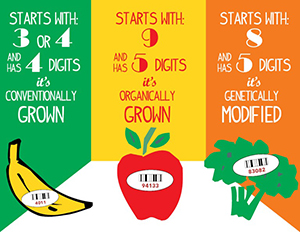
What are those #'s on Product Labels
by Ronald Grisanti D.C., D.A.B.C.O., D.A.C.B.N, M.S., CFMP
November 7, 2022 Puzzle Piece

You know those little stickers on fruits and veggies? They're called
price look-up (PLU) codes and they contain numbers that cashiers use to
ring you up. But you can also use them to make sure you're getting what
you paid for. If you are interested in staying healthy, here's what to
look for:
• A five-digit number that starts with a 9 means the item is organic. Eating
organically—or better yet, biodynamically—grown produce is paramount.
This can be identified at the grocery store by a five-digit bar code
starting with the number "9," or purchased from your local biodynamic grower.
• A four-digit code beginning with a 3 or a 4 means the produce is probably conventionally grown. For
example, regular small lemons sold in the U.S. are labeled 4033, large
are 4053; small organic lemons are coded 94033, large are
94053. We cannot emphasize enough the importance of food quality when it
comes to the prevention of disease. Sure, a conventionally grown bell
pepper (identified by a sticker with a four-digit bar code starting with
the number "4") will contain the healthy compound beta-cryptoxanthin,
but it will also come with a whole host of cancer-causing chemicals on it.
• A five-digit code that starts with an 8 means the item is genetically modified (it
has genes from other organisms). You won't see many of those because
only genetically modified versions of corn, soybeans, canola, cotton,
papaya, and squash are now widely sold. And because PLU codes aren't
mandatory, companies can label those items as conventional.
It is very important we understand product labels and use healthy foods and supplements.
We thank Dr Grisanti for this article and information.
Yours in Health and Wellness,
John W Brimhall, DC, BA, BS, FIAMA, DIBAK

(Only registered customers can rate)
There are no comments for this product.